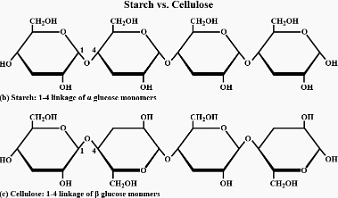What is the basic structural difference between starch and cellulose?
Solution and Explanation
Starch consists of two components - amylose and amylopectin. Amylose is a long linear chain of ∝-D-(+)-glucose units joined by C1-C4 glycosidic linkage (∝-link).
Amylopectin is a branched-chain polymer of ∝-D-glucose units, in which the chain is formed by C1-C4 glycosidic linkage and the branching occurs by C1-C6 glycosidic linkage.
On the other hand, cellulose is a straight-chain polysaccharide of β-D-glucose units joined by C1-C4 glycosidic linkage (β-link).

Top Questions on Biomolecules
- Sweetest sugar is:
- UP Board XII - 2025
- Chemistry
- Biomolecules
- Write chemical equations of two methods of preparation of glucose. How will you obtain saccharic acid and gluconic acid from glucose?
- UP Board XII - 2025
- Chemistry
- Biomolecules
- What is Tollen's reagent? Write the chemical equation of its reaction with glucose.
- UP Board XII - 2025
- Chemistry
- Biomolecules
- Product obtained by hydrolysis of inulin is –
- UP Board XII - 2025
- Chemistry
- Biomolecules
- What is Tollen's reagent? Write the chemical equation for the reactions of this reagent with glucose and fructose.
- UP Board XII - 2025
- Chemistry
- Biomolecules
Questions Asked in CBSE CLASS XII exam
- If \( \overrightarrow{a} + \overrightarrow{b} + \overrightarrow{c} = 0 \), \( |\overrightarrow{a}| = \sqrt{37} \), \( |\overrightarrow{b}| = 3 \), and \( |\overrightarrow{c}| = 4 \), then the angle between \( \overrightarrow{b} \) and \( \overrightarrow{c} \) is:
- Briefly explain how energy is produced in stars, giving two examples of the nuclear reactions involved.
- CBSE CLASS XII - 2025
- Nuclear physics
- If \( \mathbf{a} \) and \( \mathbf{b} \) are position vectors of two points \( P \) and \( Q \) respectively, then find the position vector of a point \( R \) in \( QP \) produced such that \[ QR = \frac{3}{2} QP. \]
- From the following information, calculate ‘Return on Investment’ :
Shareholders Funds ₹ 16,00,000
10% Debentures ₹ 8,00,000
Current Liabilities ₹ 2,00,000
Current Assets ₹ 5,00,000
Non-Current Assets ₹ 21,00,000
Net profit after tax was ₹ 3,00,000 and the tax amounted to ₹ 1,00,000.- CBSE CLASS XII - 2025
- Accounting Ratios
- Give reasons:
(a) Cooking is faster in a pressure cooker than in an open pan.
(b) On mixing liquid X and liquid Y, volume of the resulting solution decreases. What type of deviation from Raoult's law is shown by the resulting solution? What change in temperature would you observe after mixing liquids X and Y?- CBSE CLASS XII - 2025
- Solutions
Concepts Used:
Polysaccharides
Polysaccharides are the most abundant hydrocarbons that exist in our food. They are long chains of hydrocarbons inclusive of smaller units called monosaccharides or monomers, related to each other through glycosidic linkages. Cellulose, starch, chitin, and glycogen are the most common polysaccharides found in food.
Characteristics of Polysaccharides:
- Desiccation does not cause Polysaccharides to structure crystals.
- They do not have a candied flavor.
- Water cannot infiltrate the molecules due to the numerous hydrogen bonds, making them hydrophobic.
- They are osmotically inactive and close-packed inside the cells. Many are water-insoluble.
- They are collections of hydrogen, carbon, and oxygen. 2:1 is the ratio of hydrogen to oxygen.
- They are carbohydrates with a molecular weight comparatively more excessive than other compounds. It is also possible to extract a white powder out of it.
Types of Polysaccharides:
- Homopolysaccharides
- Heteropolysaccharides